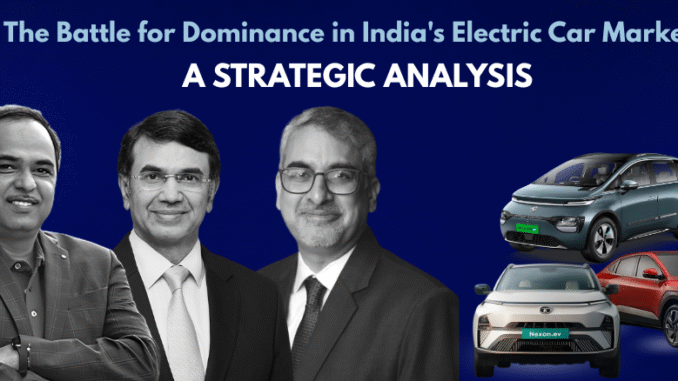
India’s electric vehicle (EV) market is at a pivotal inflection point, transitioning from a niche segment to a mainstream battleground. While Tata Motors currently commands the market with a dominant sales volume born from a first-mover advantage, its position is being strategically challenged. JSW MG Motor India is carving out valuable niches through innovative ownership models, while Mahindra & Mahindra is executing a long-term plan to leapfrog current technology. The battle for tomorrow’s market will be fiercely contested on the grounds of dedicated EV platforms, ecosystem control, and strategic innovation.
The market’s growth is explosive, projected to soar from USD 8.49 billion in 2024 to over USD 152 billion by 2030. This acceleration is fueled by a dual government push—demand-side schemes like PM E-DRIVE and supply-side Production Linked Incentives (PLI)—and the compelling economic pull of lower running costs. However, a significant hurdle remains: charging infrastructure. While India has expanded its network to over 26,000 public charging stations, the EV-to-charger ratio stands between 1:135 and 1:235 in various regions, highlighting a gap compared to the global benchmark of 1:6 to 1:20. This deficit is shifting consumer concerns from “range anxiety” to “charging anxiety”—a worry over the availability and reliability of chargers.
Quantifying the Race
An analysis of September 2025 retail sales data from the Federation of Automobile Dealers Associations (FADA) provides a clear, updated snapshot of the competitive hierarchy. Tata Motors leads, but its rivals are demonstrating significant momentum.
| Manufacturer | September 2025 Sales (Units) | Market Share (%) | Key Models |
| Tata Motors | 6,216 | ~40.5% | Nexon EV, Punch EV, Tiago EV |
| JSW MG Motor India | 3,912 | ~25.5% | Windsor EV, Comet EV, ZS EV |
| Mahindra & Mahindra | 3,243 | ~21.2% | XUV400 EV |
| Others | ~1,958 | ~12.8% | BYD, Hyundai, Kia, etc. |
| Total | 15,329 | 100% |
Strategic Deep Dive
The three main contenders are pursuing distinctly different paths to victory.
- Tata Motors: The Reigning Champion Tata’s dominance is built on frugal innovation—initially repurposing successful ICE platforms like the Nexon’s to achieve rapid, cost-effective market entry. Its strength is now amplified by the “Tata uniEVerse,” an ecosystem leveraging group companies like Tata Power for charging and Agratas for battery manufacturing, creating a self-reinforcing cycle of dominance.
- JSW MG Motor India: The Tech-Forward Challenger JSW MG avoids a direct volume war, instead targeting high-margin niches with a “barbell approach.” It offers the ultra-compact Comet EV for urban mobility and feature-packed SUVs like the ZS EV for the value-luxury segment. Its most disruptive innovation is Battery-as-a-Service (BaaS), which lowers upfront costs by allowing customers to lease the battery, directly tackling the market’s price sensitivity.
- Mahindra & Mahindra: The Legacy Giant’s Rebirth Mahindra is playing a long game with a “wait and leapfrog” strategy. While its current XUV400 EV holds a strong third position in sales, its true ambition lies in the “Born Electric” vision. Through a partnership with Volkswagen, Mahindra is developing its state-of-the-art INGLO platform—a dedicated, ground-up EV architecture poised to set new benchmarks in range and performance upon its planned 2026 launch.
This table compares the flagship models that embody each company’s strategy.
| Feature | Tata Nexon EV (Long Range) | JSW MG ZS EV (Exclusive) | Mahindra XUV400 EV (EL Pro) |
| Platform | Converted ICE / ACTI.EV | Converted ICE | Converted ICE |
| Battery Capacity | 40.5 kWh | 50.3 kWh | 39.4 kWh |
| Claimed Range (ARAI) | 465 km | 461 km | 456 km |
| Power / Torque | ~143 hp / 215 Nm | ~174 hp / 280 Nm | ~150 hp / 310 Nm |
| Key Features | Ziptron Tech, Ventilated Seats | iSMART Tech, 360° Camera, ADAS | Fastest Acceleration (0-100 in 8.3s) |
| Target Audience | Mass-market family SUV buyer | Tech-savvy, premium-focused buyer | Performance-oriented enthusiast |
| Ex-Showroom Price | Approx. ₹14-17 Lakh | Approx. ₹22-26 Lakh | Approx. ₹16-19 Lakh |
While Tata Motors owns today’s sales charts, market ownership is dynamic. JSW MG leads on strategic agility, and Mahindra’s strong current performance, combined with its ambitious bet on future-proof technology, suggests the competitive landscape is intensifying. The ultimate winner will not just sell cars but master the intersecting battlegrounds of technology platforms, charging ecosystems, and a complex policy landscape.



